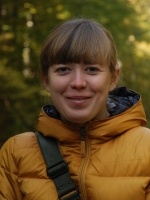Iryna Lanko

After I got my master degree in civil engineering in Belarus (2009), I obtained a second Master in Europe (JEMES program, 2011) concerning environmental engineering. Thereafter, I was employed as chief process engineer of Minsk wastewater treatment plant at the unitary enterprise of Minskvadakanal, where I used to work about 5 years until September, 2016. Among my hobbies are swimming (mainly, in the sea), travelling, photographing, reading books (Bradbery), learning languages.
I will study and characterise the anaerobic digestion processes of wastewater sludge in mesophilic and thermophilic temperature conditions: the main objects of study are biogas, digestate and supernatant. There will be not only the methane production and methane production rate measured and evaluated, but also other conditions (organic loading rate, pH, alkalinity, total suspended solids, volatile suspended solids and others). After some batch tests done, the experimental set-up will be operated with different conditions applied.
Based on the data, the life cycle assessment of, at least, two scenarios will be studied and energy effectiveness will be assessed.
Status PhD
- PhD successfully defended
- Supervisors / promoters: Pavel Jenicek, Ivet Ferrer
- Final title of the PhD thesis: Comparison of the mesophilic, thermophilic and temperature-phased anaerobic digestion of sewage sludge
- Place and date of PhD defense: Prague, 27.1.2022
- PhD degree awarding institutions: UCT Prague, UPC Barcelona
Publications arising from the PhD
- Iryna Lanko, Jakub Hejnic, Jana Říhová-Ambrožová, Ivet Ferrer, Pavel Jenicek (2021). "Digested Sludge Quality in Mesophilic, Thermophilic, and Temperature-Phased Anaerobic Digestion Systems." Water 13(20): 2839.
- Lanko, I., Flores, L., Garfí, M., Todt, V., Posada, J. A., Jenicek, P., & Ferrer, I. (2020). Life cycle assessment of the mesophilic, thermophilic, and temperature-phased anaerobic digestion of sewage sludge. Water, 12(11), 3140.
Short abstract/summary
Anaerobic digestion (AD) is currently spread all over the world for sewage sludge stabilisation, volume reduction and green energy production. Its implementation contributes to turn a wastewater treatment plant (WWTP) into a resource recovery facility.
AD processes at WWTP are studied quite well, however, there are still some issues that are open for further investigation. In this PhD Thesis, three different AD configurations were studied with regard to the following operational and functional issues:
- Digested sludge quality, dewaterability and pathogenic safety;
- AD efficiency in terms of mixing equipment and its operational regime;
- Life cycle assessment (LCA) of sludge and wastewater treatment.
Though TPAD has already been studied, a comprehensive study on the simultaneous operation of several AD systems fed with the same substrate and comparing not only the main operational AD parameters such as organic matter degradation and methane production rate, but also digested sludge quality in terms of dewaterability, pathogenic safety and energetic value, considering its final disposal step, is still missing.
Thus, one of the objectives of this PhD Thesis was to compare the mesophilic anaerobic digestion (MAD), thermophilic anaerobic digestion (TAD) and TPAD digested sludges and define the best alternatives for final disposal. The complex parameter of dewaterability was tested by two methods, centrifugation and mechanical pressing. Applying both methods, the experimental results showed that TAD and TPAD overcome MAD performance.
The AD efficiency depends on many factors, including the mixing system and its operational regime. A mixing system and its operational regime are of high practical interest, as the stirring process can affect the AD efficiency significantly, both positively and negatively. Hence, there are several studies that investigate the effectiveness of the AD process in terms of mixing efficiency. However, most of them focus on certain factors (like microbial diversity or organic matter degradation efficiency) under a single temperature regime and configuration without a parallel comparison of several AD systems.
Thus, in this PhD Thesis two different types of mixing mechanisms with two rotational regimes were selected. These mixing equipment alternatives were tested simultaneously on three laboratory AD systems with three different temperature regimes (mesophilic, thermophilic and temperature-phased) and two configurations (single- and double-stage AD) and afterwards modelled. The experiments showed that the simplest mixing mechanism at slow mixing velocity affected the AD efficiency in a better way than the more complicated mixing system at higher rotational speed.
Another issue studied was a short HRT of the first stage of the TPAD system. It was found out that even at two days of HRT at TPAD1 methane content and volume can be reached in the fermenter and maintained a at significant amount at the second stage (TPAD2). These findings were proved by the microbiological analysis of samples taken from both stages of TPAD systems.
Finally, the same three alternative anaerobic digestion systems (TAD, MAD and TPAD) were compared to determine which system may have the best environmental performance. Two life cycle assessments were performed considering: the whole WWTP (for a functional unit (FU) of 1 m3 of treated wastewater), and the sludge line (SL) alone (for FU of 1 m3 of produced methane). The data for the LCA were obtained from previous laboratory experimental work in combination with full-scale WWTP and literature. According to the results, the best AD alternative was TAD concerning all environmental impact categories, except for Climate change and Human toxicity.

